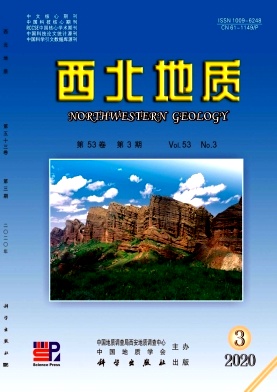|
张猛刚,雷祥义. 地球表层系统浅论[J]. 西北地质,2005,38(2):99-101.
Google Scholar
|
|
ZHANG Menggang, LEI Xiangyi. A discussion on the earth surface system[J]. Northwestern Geology, 2005, 38(2):99-101.
Google Scholar
|
|
黄润秋. 20世纪以来中国的大型滑坡及其发生机制[J]. 岩石力学与工程学报, 2007, 26(03):433-454.
Google Scholar
|
|
HUANG Runqiu. Large-Scale Landslides and Their Sliding Mechanisms in China Since the 20thCentury[J]. Chinese Journal of Rock Mechanics and Engineering, 2007, 26(03):433-454.
Google Scholar
|
|
彭建兵,范文,李喜安,等. 汾渭盆地地裂缝成因研究中的若干关键问题[J]. 工程地质学报, 2007, 15(4):433-440.
Google Scholar
|
|
PENG Jianbing, FAN Wen, LI Xian, et al. Key problems in the causative mechanism research of ground fissures in Fenwei basin[J]. Journal of Engineering Geology, 2007, 15(4):433-440.
Google Scholar
|
|
崔鹏. 我国泥石流防治进展[J]. 中国水土保持科学, 2009, 7(5):7-13, 31.
Google Scholar
|
|
CUI Peng. Advances in debris flow prevention in China[J]. Science of Soil and Water Conservation, 2009, 7(5):7-13, 31.
Google Scholar
|
|
化建新,郑建国,等. 工程地质手册(第五版)[M]. 北京:中国建筑工业出版社, 2018.
Google Scholar
|
|
HUA Jianxin, ZHENG Jianguo, et al.Engineering geology manual[M]. Beijing:China Architecture & Building Press, 2018.
Google Scholar
|
|
何登发,单帅强,张煜颖,等. 雄安新区的三维地质结构:来自反射地震资料的约束[J]. 中国科学:地球科学, 2018, 48(09):1207-1222.
Google Scholar
|
|
HE Dengfa, SHAN Shuaiqiang, ZHANG Yuying, et al. 3-D geologic architecture of Xiong'an New Area:Constraints from seismic reflection data[J]. Science China Earth, Science, 2018, 48(09):1207-1222.
Google Scholar
|
|
陈志新,袁志辉,彭建兵,等. 渭河盆地地裂缝发育基本特征[J]. 工程地质学报, 2007, 15(04):441-447.
Google Scholar
|
|
CHEN Zhixin, YUAN Zhihun, PENG Jianbing, et al. Basic Characteristics about Ground Fractures' Development of Weihe Basin[J]. Journal of Engineering Geology, 2007, 15(04), 441-447.
Google Scholar
|
|
杜蕾,谢婉丽. 城市地质环境承载力研究进展及展望[J]. 防灾科技学院学报, 2018, 20(2):15-20.
Google Scholar
|
|
DU Lei, XIE Wanli. Research Progress and Prospect of Urban Geological Environment Carrying Capacity[J]. Journal of Institute of Disaster Prevention, 2018, 20(2):15-20.
Google Scholar
|
|
张茂省,王尧. 基于风险的地质环境承载力评价[J]. 地质通报,2018,37(2-3):467-475.
Google Scholar
|
|
ZHANG Maosheng, WANG Xiao. Research on the evaluation of the carrying capacity of geological environment based on its risk level[J]. Geological Bulletin of China, 2018, 37(2-3):467-475.
Google Scholar
|
|
张茂省,王化齐,王尧,等. 中国城市地质调查进展与展望[J]. 西北地质,2018, 51(4):1-9.
Google Scholar
|
|
ZHANG Maosheng, WANG Qihua, WANG Yao, et al. Progress and prospect of urban geological survey in China[J]. Northwestern Geology, 2018, 51(4):1-9.
Google Scholar
|
|
王斌. 渭河盆地新生代沉积演化盆山耦合与风尘沉积[D]. 南京大学, 2014.
Google Scholar
|
|
WANG Bin. Cenozoic sedimentary evolution of the Weihe basin:Basin-Orogen coupling and eolian sediments[D]. Nanjing University, 2014.
Google Scholar
|
|
刘林,芮会超,杨莉. 渭河单冲压陷盆地的厘定及其控藏作用[J]. 西北地质, 2018, 51(2):186-202.
Google Scholar
|
|
LIU Lin, RUI Huichao, YANG Li. Definition of the Weihe single-thrusting compressional basin and its reservoir-forming condition[J].Northwestern Geology, 2018, 51(2):186-202.
Google Scholar
|
|
张世民. 汾渭地堑系盆地发育进程的差异及其控震作用[J]. 地质力学学报, 2000, 02:30-37.
Google Scholar
|
|
ZHANG Shimin. Basin evolutionary differences and seismotectonics of Fenwei graben system[J].Journal of Geomechanics, 2000, 02:30-37.
Google Scholar
|
|
王景明.渭河地堑断裂构造研究[J]. 地质论评, 1984, (03):217-223.
Google Scholar
|
|
WANG Jingming. A study on the tectonics of Weihe graben[J]. Geological Review, 1984, (03):217-223.
Google Scholar
|
|
易明初. 新构造运动及渭延裂谷构造[M]. 北京:地震出版社, 1993.
Google Scholar
|
|
YI Mingchu. Neotectonic movement and Weihe rift structure[M]. Beijing:Seismological Press, 1993.
Google Scholar
|
|
任隽.渭河盆地深部地壳结构探测与盆地构造研究[D]. 西安:长安大学,2012.
Google Scholar
|
|
REN Jun.Deep crustal structure exploration and basin structure study in the Weihe Basin[D]. Xi'an:Chang'an University, 2012.
Google Scholar
|
|
瞿伟,张勤,王庆良,等. 渭河盆地现今地壳水平形变特征及区域构造活动性[J]. 武汉大学学报(信息科学版), 2011, 36(07):830-834.
Google Scholar
|
|
QU Wei, ZHANG Qin, WANG Qingliang, et al. Research on present crustal horizontal deformation feature of Weihe Basin and its tectonic activity[J]. Geomatics and Information Science of Wuhan University, 2011, 36(7):830-834.
Google Scholar
|
|
权新昌. 渭河盆地断裂构造研究[J]. 中国煤田地质, 2005, 17(03):1-4,8.
Google Scholar
|
|
QUAN Xinchang. Weihe basin faulted structure study[J]. Coal Geology of China, 2005, 17(03):1-4,8.
Google Scholar
|
|
刘志武,周立发. 渭河盆地新生代构造-沉积格局与油气成藏潜力初探[J]. 福州大学学报(自然科学版), 2015, 43(05):708-714.
Google Scholar
|
|
LIU Zhiwu, ZHOU Lifa. The Cenozoic tectonic and sedimentary framework and preliminary study on the hydrocarbon accumulation potential of the Weihe basin[J]. Journal of Fuzhou University (Natural Science Edition), 2015, 43 (05):708-714.
Google Scholar
|
|
彭建兵,张俊,苏生瑞,等. 渭河盆地活动断裂与地质灾害[M]. 西安:西北大学出版社,1992.
Google Scholar
|
|
PENG Jianbing, ZHANG Jun, SU Shengrui, et al. Active fault and Geo-hazard in Weihe Basin[M]. Xi'an:Northwestern University Press, 1992.
Google Scholar
|
|
刘瑞平,朱桦,杨炳超,等. 大荔潜水含水层中氟的赋存规律及水化学成因[J]. 西北地质,2008, 41(4):134-140.
Google Scholar
|
|
LIU Runping, ZHU Hua, YANG Bingchao, et al. Occurrence pattern and hydrochemistry cause of the shallow groundwater fluoride in the Dali county, Shaanxi province[J]. Northwestern Geology, 2008, 41(4):134-140.
Google Scholar
|
|
王景明. 关中平原区的新华夏系构造[J]. 西北地震学报, 1981, 3(02):69-77.
Google Scholar
|
|
WANG Jingming. The neocathaysian structural system of Guanzhong plain[J]. Northwestern Seismological Journal, 1981,3(02):69-77.
Google Scholar
|
|
乔建伟. 基于地球关键带理论的渭北台塬地裂缝成因机理研究[D]. 西安:长安大学,2018.
Google Scholar
|
|
QIAO Jianwei. Study on the formation mechanism of ground fissures in Weibei terrace based on earth's critical zone theory[D]. Xi'an:Chang'an University, 2018.
Google Scholar
|
|
李高阳,李陈侠,李晓妮. 1501年渭南朝邑7.0级地震发震断裂初探[J]. 华南地震, 2018, 38(S1):108-111.
Google Scholar
|
|
LI Gaoyang, LI Chenxia, LI Xiaoni. Preliminary study on the seismogenic faults of Chaoyi M7.0 earthquake in 1501[J]. South China Journal of Seismology, 2018, 38(S1):108-111.
Google Scholar
|
|
杜建军. 渭河盆地东南缘主要断裂晚更新世以来的活动性和灾害效应[D]. 北京:中国地质科学院,2016.
Google Scholar
|
|
DU Jianjun. Activity of main faults and related geohazard effects in Southeast of Weihe basin[D]. Beijing:Chinese Academy of Geological Sciences, 2016.
Google Scholar
|
|
National Research Council. New research opportunities in the earth science[M]. Washington DC:National Academy Press, 2001.
Google Scholar
|
|
NSF. Frontiers in Exploration of the Critical Zone[R/OL]. 2005. http://www.czen.org/file/czen/EZEN_Booklet.pdf.
Google Scholar
|
|
LIN H. Earth's critical zone and hydropedology:concepts, characteristics and advance[J]. Hydrology and Earth System Science, 2010, 14:25-45.
Google Scholar
|
|
QIAO JW, PENG JB, DENG YH, et al. Earth fissures in Qinglong Graben in Yuncheng Basin, China[J]. Journal of Earth System Science, 2018, 127:10.
Google Scholar
|






 DownLoad:
DownLoad: